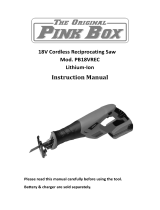Craftsman 315114270 Owner's manual
- Category
- Grass trimmers
- Type
- Owner's manual
This manual is also suitable for
Craftsman 315114270 is a 19.2-volt reciprocating saw with a variable speed and a 7/8-inch stroke. It's ideal for cutting through wood, metal, and plastic. The saw features a keyless blade clamp for quick and easy blade changes and an ergonomic handle for comfortable use. It also comes with a dust blower to keep the cutting area clear of debris. With its powerful motor, variable speed, and durable construction, the Craftsman 315114270 is a versatile and reliable tool for any homeowner or DIY enthusiast.
Craftsman 315114270 is a 19.2-volt reciprocating saw with a variable speed and a 7/8-inch stroke. It's ideal for cutting through wood, metal, and plastic. The saw features a keyless blade clamp for quick and easy blade changes and an ergonomic handle for comfortable use. It also comes with a dust blower to keep the cutting area clear of debris. With its powerful motor, variable speed, and durable construction, the Craftsman 315114270 is a versatile and reliable tool for any homeowner or DIY enthusiast.
















-
 1
1
-
 2
2
-
 3
3
-
 4
4
-
 5
5
-
 6
6
-
 7
7
-
 8
8
-
 9
9
-
 10
10
-
 11
11
-
 12
12
-
 13
13
-
 14
14
-
 15
15
-
 16
16
Craftsman 315114270 Owner's manual
- Category
- Grass trimmers
- Type
- Owner's manual
- This manual is also suitable for
Craftsman 315114270 is a 19.2-volt reciprocating saw with a variable speed and a 7/8-inch stroke. It's ideal for cutting through wood, metal, and plastic. The saw features a keyless blade clamp for quick and easy blade changes and an ergonomic handle for comfortable use. It also comes with a dust blower to keep the cutting area clear of debris. With its powerful motor, variable speed, and durable construction, the Craftsman 315114270 is a versatile and reliable tool for any homeowner or DIY enthusiast.
Ask a question and I''ll find the answer in the document
Finding information in a document is now easier with AI
Related papers
-
Craftsman 10" Compound Miter Saw (21236) Manufacturer's Warranty
-
Craftsman 315.115460 Owner's manual
-
Craftsman 315274050 Owner's manual
-
Craftsman 315171070 Owner's manual
-
Craftsman 315115790 Owner's manual
-
Craftsman 315171081 Owner's manual
-
Craftsman 315271290 Owner's manual
-
Craftsman 32026314 Owner's manual
-
Craftsman 911 041 User manual
-
Craftsman 315.114010 User manual

















